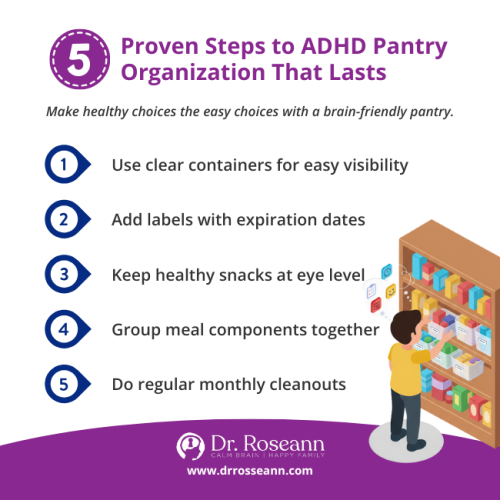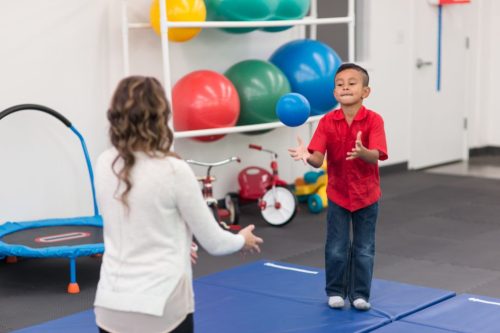Estimated reading time: 7 minutes
A smarter grocery list can truly help calm your child’s brain and set the stage for better focus—without turning mealtimes into a battle.
Research shows that many children with ADHD often have lower levels of key nutrients like omega-3 fatty acids, zinc, iron, and certain B-vitamins compared to their peers. Because these nutrients are so important for brain function, gaps can make it harder for kids to manage attention, mood, and behavior.
The good news is that what you put in your cart can make a real difference. In this complete food guide, you’ll learn which foods nourish your child’s brain, which ones may be working against them, and how to stock an ADHD-friendly kitchen that supports calmer behavior and better focus.
What Foods Should I Buy for My Child’s ADHD Diet?
Think of your cart as brain medicine. Choose protein, complex carbs, and healthy fats every day to support steady energy and regulation.
ADHD Grocery List (scan-friendly)
| Category | Stock Up On | Why it HelpsProtein powerhouses |
|---|---|---|
| Protein powerhouses | Salmon, sardines, mackerel; organic eggs; grass-fed beef; chicken/turkey; Greek yogurt (plain); beans, lentils, chickpeas; natural nut/seed butters | Protein supports dopamine & satiety → fewer crashes |
| Complex carbs | Steel-cut oats, quinoa, brown/wild rice, sweet potatoes, whole-grain bread (short ingredient list)Slow energy for sustained focus | Slow energy for sustained focus |
| Healthy fats | Avocado, olive oil, walnuts, chia, flax, hemp heartsAnti-inflammatory; supports myelin & attention | Anti-inflammatory; supports myelin & attention |
| Produce “rainbow”Berries, apples, oranges; spinach/kale, broccoli, peppers, carrots, beets, cabbage | Berries, apples, oranges; spinach/kale, broccoli, peppers, carrots, beets, cabbage | Antioxidants protect brain cells |
| School snacks | Cheese sticks, hummus + veggie sticks, trail mix, applesauce (unsweetened) | Easy, low-sugar fuel |
Remember: Behavior is communication. When you consistently fill your cart with brain-nourishing foods, your child’s behavior often improves naturally.
Which Foods Should I Avoid on My ADHD Grocery List?
Behavior isn’t bad parenting—it’s often a dysregulated brain reacting to ingredients that spike cortisol or inflammation.
Skip or minimize
| Aisle | Avoid | Swap Instead |
|---|---|---|
| Artificial additives | Red 40, Yellow 5, Blue 1; “artificial flavors/sweeteners”; BHT/BHA; MSG; “natural flavors” (catch-all) | Whole foods; short-label items |
| Sugary/refined | Sugary cereals, pastries, candy, soda/juice, white breads, chips | Oats, whole-grain crackers, fruit + nut butter, sparkling water |
| Processed meats | Nitrates/nitrites (hot dogs, deli meats) | Nitrate-free turkey/chicken; rotisserie chicken |
| Caffeine | Energy drinks, colas | Water, herbal teas |
| Potential triggers | Gluten/dairy (if sensitive), high-histamine (aged cheeses/processed meats) | Trial eliminations guided by a diary & provider |
Clinical note: When 9-year-old Eli’s family eliminated food dyes from their grocery list, his hyperactivity decreased by 40% within two weeks. His mom said, “I couldn’t believe something so simple could make such a difference.”
How Do I Create an ADHD-Friendly Meal Plan?
Use my simple formula: Protein + Complex Carb + Healthy Fat at each meal.
Sample 3-Day Plan (mix & match)
| Meal | Day 1 | Day 2 | Day 3 |
|---|---|---|---|
| Breakfast | Eggs + avocado toast | Greek yogurt + berries + ground flax | Protein smoothie (spinach, banana, almond butter) |
| Lunch | Turkey & hummus wrap + veggies | Lentil soup + whole-grain crackers | Salmon salad + brown rice + broccoli |
| Dinner | Baked cod + sweet potatoes + green beans | Beef stir-fry + veggie rainbow + brown rice | Chicken + quinoa pilaf + sautéed spinach |
Make-ahead ideas: Batch cook quinoa/rice; roast a sheet pan of veggies; portion proteins; overnight oats for grab-and-go.
Real Family Strategy: “I spend one hour on Sunday prepping proteins and grains. During the week, I just combine them with fresh vegetables. It’s saved my sanity and improved my son’s focus dramatically.” – Jennifer, working mom of twins
What Are the Best Snacks for ADHD Focus?
Strategic snacking can be your secret weapon for maintaining your child’s focus throughout the day. The key is combining protein with complex carbohydrates to prevent blood sugar crashes that trigger ADHD symptoms.
Focus-Boosting Snack Combinations:
Morning Snacks (Brain Fuel):
- Apple slices with almond butter
- Hard-boiled egg with whole grain crackers
- Greek yogurt with berries and hemp hearts
- Homemade trail mix with nuts, seeds, and dark chocolate chips
Afternoon Snacks (Sustained Energy):
- Hummus with colorful vegetable sticks
- Cheese cubes with grapes and walnuts
- Smoothie with protein powder and greens
- Avocado toast on whole grain bread
Evening Snacks (Calming):
- Banana with peanut butter
- Warm almond milk with cinnamon
- Small portion of nuts and seeds
- Herbal tea with a few dates

How Can I Make ADHD Grocery Shopping Easier?
ADHD brains love systems. Make healthy choices the easy choices.
- Plan 3–4 dinners; repeat favorites.
- Keep a running phone list by store section.
- Shop after eating; bring a protein snack.
- Go off-peak (early morning/evening).
- Give kids a job (“Find 4 red peppers”); set a 20-minute time limit.
Parent hack: “I photograph the pantry before leaving—no more duplicate buys.” — David

Should I Buy Organic Foods for ADHD?
While organic isn’t always necessary for ADHD management, certain foods are worth the extra investment because of their higher pesticide residue levels, which can worsen ADHD symptoms in sensitive children.
- Always (Dirty Dozen + ADHD picks): strawberries, spinach, kale, apples, grapes, peaches, bell peppers, celery, tomatoes, potatoes; oats & wheat if frequently eaten.
- If budget allows: dairy, eggs, poultry, ground beef, soy.
- Usually fine (Clean Fifteen): avocados, sweet corn, pineapple, onions, papaya, frozen peas, asparagus, mango, eggplant, honeydew, kiwi, cantaloupe.
- Budget tips: frozen organic produce, store brands, bulk, seasonal.
What Supplements Should I Add to My ADHD Grocery List?
While whole foods should be your foundation, clinical research shows that certain supplements can significantly improve ADHD symptoms when added to a healthy diet. Think of supplements as targeted nutrition for your child’s specific brain needs.
Evidence-Based ADHD Supplements for Your Shopping List:
Tier 1: Strong Research Support
- Omega-3 (EPA/DHA): Look for 1000mg+ with higher EPA
- Magnesium Glycinate: Most absorbable form, calms nervous system
- Probiotics: Multi-strain with at least 10 billion CFUs
- Vitamin D3: Especially important if your child has limited sun exposure
Tier 2: Promising Research
- Zinc Picolinate: Only if testing shows deficiency
- B-Complex: Look for methylated forms for better absorption
- Iron: Must test levels first—only supplement if deficient

How Do I Stock My Pantry for ADHD Success?
A well-stocked ADHD-friendly pantry is your insurance policy against poor food choices and mealtime battles. When healthy options are always available, good nutrition becomes automatic.
ADHD Pantry Essentials Shopping List:
- Proteins: canned wild salmon/sardines, nut/seed butters, protein powder, canned beans/lentils, raw nuts/seeds.
- Complex carbs: steel-cut oats, quinoa, brown/wild rice, whole-grain pasta, sweet potatoes.
- Fats & flavor: olive/avocado oil, chia/flax, tahini, herbs/spices, ACV, lemon.
- Emergency meal kit: broth, coconut milk, no-sugar tomato sauce, frozen veggies/berries.

Family Success Story: “Once I organized our pantry with clear containers and healthy options front and center, my kids started making better choices on their own. It’s like having a healthy convenience store at home.” – Shondra, mom of three
Brain Science Spotlight
A 2014 meta-analysis led by Dr. Joel Nigg at Oregon Health & Science University found that children with ADHD tend to have significantly lower blood levels of omega-3 fatty acids compared to neurotypical peers. Omega-3s are essential fats that support attention, impulse control, and emotional regulation, and low levels reflect underlying brain biology—not willful defiance.
What this means for your family: Prioritize omega-3-rich foods like salmon, sardines, walnuts, flaxseeds, and chia seeds several times a week, and pair them with fiber-rich foods such as oats, beans, and vegetables for steadier energy. Some studies show that consistent intake of omega-3s may lead to modest improvements in focus and behavior over time, though results vary. Always talk with your child’s provider before adding supplements.
Dr. Roseann’s Therapist Quick Tip
In my 30+ years of clinical practice, I’ve learned that consistency beats perfection every time. Here’s what I tell parents: build a tiny, repeatable routine around breakfast and snacks.
Try this today: Choose one swap—replace sugary cereal with eggs + fruit 4 mornings this week.
Why it works: Predictable protein stabilizes blood sugar and supports dopamine, which reduces impulsivity and tantrums.
Remember: It’s not bad parenting—it’s a dysregulated brain. You’ve got this.
You don’t have to change everything overnight. What makes the biggest difference is starting small and staying consistent.
Begin by choosing omega-3s and quality proteins, go organic where it really counts, and keep your pantry stocked with easy, healthy options you can grab in a pinch.
Remember, behavior is communication—not defiance—and when you calm the brain first, focus and cooperation follow. You’re not failing, you’re learning alongside your child, and it’s truly going to be OK.
FAQs
How much will ADHD-friendly groceries cost?
Plan a 15–20% bump the first month while you stock staples; costs usually drop as eating out and junk snacks decline.
Can I find these foods in regular stores?
Yes. Shop the perimeter (produce, proteins, dairy/frozen veggies), then read labels in the inner aisles.
What if my child refuses new foods?
Keep exposure gentle. It can take 10–15 tries. Pair tiny tastes with favorites; avoid pressure. Behavior is communication.
Should my child come shopping?
If regulated and fed, yes—with a specific job and a time limit. Mornings are usually calmer.
How do we handle cravings for processed foods?
Expect 2–3 weeks of transition. Keep protein + fiber alternatives ready; cravings ease as blood sugar stabilizes.
Citations:
Hawkey, E., & Nigg, J. T. (2014). Omega-3 fatty acid and ADHD: Blood level analysis and meta-analytic extension of supplementation trials. Clinical Psychology Review, 34(6), 496–505. https://doi.org/10.1016/j.cpr.2014.05.005
Chang, J. P. C., Su, K. P., Mondelli, V., & Pariante, C. M. (2018). Omega-3 polyunsaturated fatty acids for core symptoms of attention-deficit/hyperactivity disorder: Meta-analysis of randomized controlled trials. The Journal of Clinical Psychiatry, 79(4), 17r12061. https://doi.org/10.4088/JCP.17r12061
Abdelkarim, O. R., Mahmoud, M. M., & El-Gawad, A. A. (2021). Impact of diet modification on outcome of children with attention deficit hyperactivity disorder. Bulletin of the National Research Centre, 45(1), 24. https://doi.org/10.1186/s42269-020-00466-x
Lange, K. W., Hauser, J., & Reissmann, A. (2023). Nutrition in the management of ADHD: A review of recent research. Current Nutrition Reports, 12(3), 291–302. https://doi.org/10.1007/s13668-023-00487-8
Sonuga-Barke, E. J. S., Brandeis, D., Cortese, S., Daley, D., Ferrin, M., Holtmann, M., Stevenson, J., Danckaerts, M., van der Oord, S., Döpfner, M., Dittmann, R. W., Simonoff, E., Zuddas, A., Banaschewski, T., Buitelaar, J., Coghill, D., Hollis, C., Konofal, E., Lecendreux, M., … Sergeant, J. (2013). Nonpharmacological interventions for ADHD: Systematic review and meta-analyses of randomized controlled trials of dietary and psychological treatments. PLoS ONE, 8(4), e62035. https://doi.org/10.1371/journal.pone.0062035
Always remember… “Calm Brain, Happy Family™”
Disclaimer: This article is not intended to give health advice and it is recommended to consult with a physician before beginning any new wellness regime. *The effectiveness of diagnosis and treatment vary by patient and condition. Dr. Roseann Capanna-Hodge, LLC does not guarantee certain results.
Are you looking for SOLUTIONS for your struggling child or teen?
Dr. Roseann and her team are all about science-backed solutions, so you are in the right place!
©Roseann Capanna-Hodge








